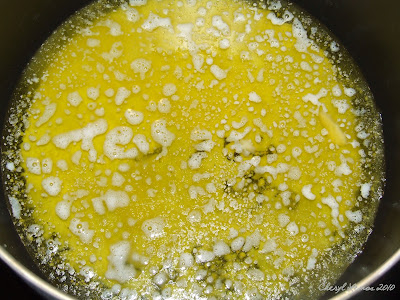In previous posts I showed you how easy it is to make and store butter. In this post I’m taking butter to a whole new level.
Clarifying butter is the process of separating the milk solids and water from the butterfat. The pure golden liquid has a different taste than regular butter but it has a more buttery flavor than other oils. The intensity of flavor of the clarified butter depends on how long you cook the melted butter. If you continue to cook the butter once it has melted and separated, the milk solids at the bottom of the saucepan will start to brown. Once the milk solids turn a golden brown color the clarified butter will take on a rich fragrant nutty flavor that is called "noisette butter"(1) because it is similar in color and flavor to hazelnuts. However, be very careful not to overheat the butter or it will become bitter tasting.
Also called drawn butter, there are many benefits of clarified butter.
It has a longer shelf life. It lasts several months longer than regular butter if kept refrigerated. Although pure clarified butter does not need to be refrigeration, it is recommended unless you’re completely certain you’ve removed all the milk fats which will cause it to go rancid.
You can use clarified butter as you would in any recipe; however, it has a higher smoke point which means that you can cook at higher temperatures than you can with regular butter. It is excellent for sautéing and can be substituted for oil for frying.
Clarified butter is much lighter an oil than nut oils, so it is easier to digest. And be cause the milk solids and proteins are removed, people with milk allergies can usually tolerate it.
To make clarified butter gently melt unsalted butter over low heat until the butter breaks down and three layers form.
The top layer is a white foam that contains the whey proteins. Theses should be skimmed off with a spoon.
The milk solids will drop to the bottom of the saucepan and form a milky layer of sediment.
What is left in the middle is a pure golden-yellow liquid called clarified butter.
When you have skimmed all the white foam from the surface of the clarified butter, and it has stopped bubbling, remove the saucepan from the heat. Let the butter sit a few minutes to allow the milk solids to further settle to the bottom, and then either pour off the liquid or strain the mixture through a fine sieve or a cheesecloth-lined strainer.
Turning up the heat will melt the butter faster, but the milk solids may begin to burn, so, resist the temptation. Instead, you can cut up the butter into pieces to speed up melting. Also, if you don't have a small saucepan, it may be best to use more butter. Too little butter in a large diameter pan will make it difficult to separate the solids from the fat later.
The smoke point of a particular oil is the temperature at which the oil begins to decompose and visible fumes (smoke) are given off. The oil begins to breakdown creating acreolein , an obnoxious-smelling compound.
The smoke point of regular butter is 350 Degrees F versus 485 Degrees F for clarified butter.
You can discard the milk solids or use them as a rich topping for popcorn.
YUM!
(1) Noisette is French for hazelnut.








No comments:
Post a Comment